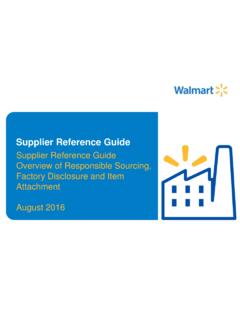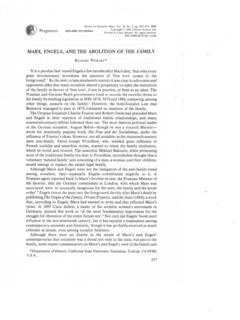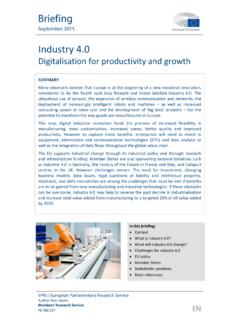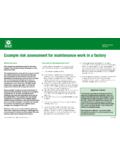Transcription of FSRA Factories Warehouses - GOV.UK
1 FactoriesandwarehousesThis guide is for employers, managers, occupiers and ownersof Factories and Warehouses . It tells you what you have to doto comply with fire safety law, helps you to carry out a fire riskassessment and identify the general fire precautions you needto have in guides in the series:ISBN-13: 978 1 85112 816 7 ISBN-10: 1 85112 816 6 Price: 12 FireSafetyRiskAssessment FactoriesandwarehousesHMGovernmentOffice s and shopsISBN-13: 978 1 85112 815 0 Offices and retail premises (including individual units within larger premises, shopping centres). Factories and warehousesISBN-13: 978 1 85112 816 7 Factories and warehouse storage premises. Sleeping accommodation ISBN-13: 978 1 85112 817 4 All premises where the main use is to provide sleeping accommodation, hotels,guest houses, B&Bs, hostels, residential training centres, holiday accommodationand the common areas of flats, maisonettes, HMOs and sheltered housing (otherthan those providing care see Residential care premises), but excluding hosptials,residential care premises, places of custody and single private dwellingsResidential care premisesISBN-13: 978 1 85112 818 1 Residential care and nursing homes, common areas of sheltered housing(where care is provided) and similar premises, which are permanently staffedand where the primary use is the provision of care rather than healthcare (seeHealthcare premises).
2 Educational premisesISBN-13: 978 1 85112 819 8 Teaching establishments ranging from pre-school through to universities, exceptthe residential parts (see Sleeping accommodation).Small and medium placesof assemblyISBN-13: 978 1 85112 820 4 Smaller public houses, clubs, restaurants and caf s, village halls, communitycentres, libraries, marquees, churches and other places of worship or studyaccommodating up to 300 people. Large places of assemblyISBN-13: 978 1 85112 821 1 Larger premises where more than 300 people could gather, shopping centres(not the individual shops), large nightclubs and pubs, exhibition and conferencecentres, sports stadia, marquees, museums, libraries, churches, cathedrals andother places of worship or , cinemas andsimilar premisesISBN-13: 978 1 85112 822 8 Theatres, cinemas, concert halls and similar premises used primarily forthis air events and venuesISBN-13: 978 1 85112 823 5 Open air events, theme parks, zoos, music concerts, sporting events(not stadia see Large places of assembly), fairgrounds and county fairs.
3 Healthcare premisesISBN-13: 978 1 85112 824 2 Premises where the primary use is the provision of healtcare (including private), hospitals, doctors surgeries, dentists and other similar healthcare premisesand facilitiesISBN-13: 978 1 85112 825 9 Transportation terminals and interchanges, airports, railway stations(including sub-surface), transport tunnels, ports, bus and coach stations andsimilar premises but excluding the the means of transport ( trains, buses,planes and ships). GuideMain use Department for Communities and Local Government PublicationsPO Box 236 WetherbyWest YorkshireLS23 7 NBTel: 0870 830 7099 Fax: 0870 1226 237 Textphone: 0870 1207 405E-mail: document is also available on the DCLG website: number: 05 FRSD 03338 (b)Published by the Department for Communities and Local Government, Eland House, Bressenden PlaceLondon SW1E 5DU, May 2006.
4 Crown Copyright 2006. Printed on material containing 100% post-consumer waste (text), 75% post-consumer waste and 25% ECF pulp (cover). ISBN-13: 978 1 85112 816 7 ISBN-10: 1 85112 816 6 Copyright in the contents, the cover, the design and the typographical arrangement rests with the document/publication is value added. If you wish to re-use this material, please apply for a Click-Use Licence for value added material at applications can be sent to:OPSI, Information Policy Team, St Clements House, 2-16 Colegate, Norwich NR3 1 BQFax: 01603 723000E-mail: publication has been approved by Ministers and has official status. The contents of this publication may bereproduced free of charge in any format or medium for the purposes of private research and study or for internalcirculation within an organisation.
5 This is subject to the contents being reproduced accurately and not in a way thatimplies official status. Any publisher wishing to reproduce the content of this publication must not use or replicatethe HMG logo or replicate the official version s style and appearance, including the design, and must not presenttheir publication as being an official publication as this may confuse the public. The reproduced material must beacknowledged as Crown Copyright and the title of the publication specified. HM Government does not accept anyresponsibility for the accuracy and the comprehensiveness of any other other use of the contents of this publication would require a copyright licence. Further information can obtainedfrom routes 85, 86fire detection and warning systems 7, 31, 32,57, 61 2, 65, 110, 119 21fire doors 7, 17, 119, 120, 121, 127, 129firefighting equipment and facilities 7, 19, 23,30, 31, 32, 61 2, 64, 65, 110, 119, 120, 121mezzanine floors 50, 89, 91multi-occupied buildings 4, 5emergency plans 35, 36, 110escape routes 67fire detection and warning systems 21fire risk assessment 15information and instruction 107, 108 Ooxygen, sources of 12, 14, 19 Ppartitions, fire-resisting 26, 50, 53, 123see alsowallspeople at riskevaluating 16 17identifying 11,14 15, 33, 122removing or reducing risk 4 5, 20 32, 33, 122restricting the spread of fire and smoke50, 52 3type and number using premises 25, 39, 68people with special needs 14evacuating 24, 27.
6 28, 54, 57, 68 9, 116, 117fire warning systems 55information and instruction 36, 107personal emergency evacuation plans (PEEPs)25, 54piping 46plans and specifications 33, 34,112portable appliance testing (PAT) 48 Rradiation, fire spreading by 16reception areas 84record-keepingemergency escape lighting 106, 110fire detection and warning systems 57, 110fire risk assessment 9, 11,33 4, 110, 111,112, 122refuge areas 27, 68, 69,112, 135rising mains 23, 64, 121riskdefinition 9evaluating 11,15 17, 66people at risk 11,14, 16 17reducing 4 5, 11,20 32, 33, 43 6roll calls 114, 117roller shutter doors 65, 87, 120roof exits 86, 87 Ssecurity 53shafts, firefighting seeliftssigns and notices 23, 29 30, 107 9information and instruction 36, 49smokecontrol of 52, 53, 56, 79, 102, 110, 121dangers of 17spread of 17, 38, 50, 52 3 Smoke and Heat Exhaust Ventilation Systems(SHEVS)
7 53, 56, 121smoke detectors 73, 78, 127, 135smoking 12, 15, 18, 49sprinklers 19, 23, 42, 61 2, 63, 116, 120stafffire drills 37, 38, 110, 116 17fire safety training 7, 20, 23, 27, 33, 35 6,37 8, 59, 115 17information and instruction 7, 35 7, 108 9, 113see alsocontractorsstairwaysaccommodation stairways 80, 84, 132basements 78, 79,94, 98 100bypass routes 83, 84external 85, 87,133hazards in 10, 50protected 24, 80 3, 85, 88, 94, 95, 101, 135spiral and helical 86width and capacity of 70storage 18 19, 42 6, 50, 53, 54, 114outdoor 43racking 13, 17, 25, 27, 42, 44, 72 Ttrainingfire safety 6, 20, 27, 33, 35 6, 37 8, 115 17firefighting equipment 7, 23, 38, 59, 116 Vventilation systems 14, 17, 19, 39, 53, 56, 121vision panels 67, 73, 126, 136voids 43, 50, 66, 67, 124, 130 Wwallsfire-resisting 26, 47, 53, 67, 77,123insulated core panels 42, 44, 51 2lining materials 14, 19, 123see alsopartitionswarehousesemergency escape lighting 28, 104escape routes 28, 38, 43, 68, 71, 92,104, 107fire safety management 41open-plan 50, 104sources of fuel 13 14, 43storage 43, 46waste and packaging, combustible 13, 15, 16,19, 42, 43, 53way guidance systems 29, 105, 136windows, fire-resisting 85, 86, 124, 126vision panels 67, 73, 126, 136 Part2 Furtherguidanceonfireriskassessmentandfi reprecautions145 ContentsHow to use this guide2 Preface3 Introduction4 Part 1 Fire risk assessment9 Step 1 Identify fire hazards12 Step 2 Identify people at risk14 Step 3 Evaluate, remove, reduce and protect from risk15 Step 4 Record, plan, inform.
8 Instruct and train33 Step 5 Review38 Part 2 Further guidance on fire risk assessment and fire precautions41 Section 1 Further guidance on fire risks and preventative measures42 Section 2 Further guidance on fire detection and warning systems55 Section 3 Further guidance on firefighting equipment and facilities59 Section 4 Further guidance on escape routes66 Section 5 Further guidance on emergency escape lighting104 Section 6 Further guidance on signs and notices107 Section 7 Further guidance on recording, planning, informing, instructing and training110 Section 8 Quality assurance of fire protection equipment and installation118 Appendix A Example fire safety maintenance checklist119 Appendix B Technical information on fire-resisting separation, fire doorsand door fastenings123 Appendix C Historic buildings130 Appendix D Glossary132 References137 Further reading140 Index1431 How to use this guideThis guide is divided into two parts: Part 1 Explains what fire risk assessment is and how you might go about it.
9 Firerisk assessment should be the foundation for all the fire precautions in your premises. Part 2 Provides further guidance on fire precautions. The information is providedfor you and others to dip into during your fire risk assessment or when you arereviewing your appendices provide example checklists, some detailed technical informationon fire-resisting elements and advice on historic guide is one from a series of guides listed on the back rest of this introduction explains how the law terms are explained in the glossary and references to other publicationslisted at the end of this book are identified by a superscript number in the this guide reference is made to British Standards and standards provided byother bodies. The standards referred to are intended for guidance only and otherstandards could be used.
10 Reference to any particular standard is not intended toconfer a presumption of conformity with the requirements of the Regulatory Reform(Fire Safety) Order 2005 (the Order).1 The level of necessary safety (or service) must be dictated by the findings of yourrisk assessment so you may need to do more or less than that specified in anyparticular standard referred to. You must be prepared to show that what you havedone complies with any requirements or prohibitions of the Order1irrespective ofwhether you have relied on a particular full list of references, , can be found at the back of this guidance gives advice on how to avoid fires and how to ensure people ssafety if a fire does start. Why should you read it? Because: Fire kills. In 2004 (England and Wales) fire and rescue services attended over33,400 fires in non-domestic buildings.
















